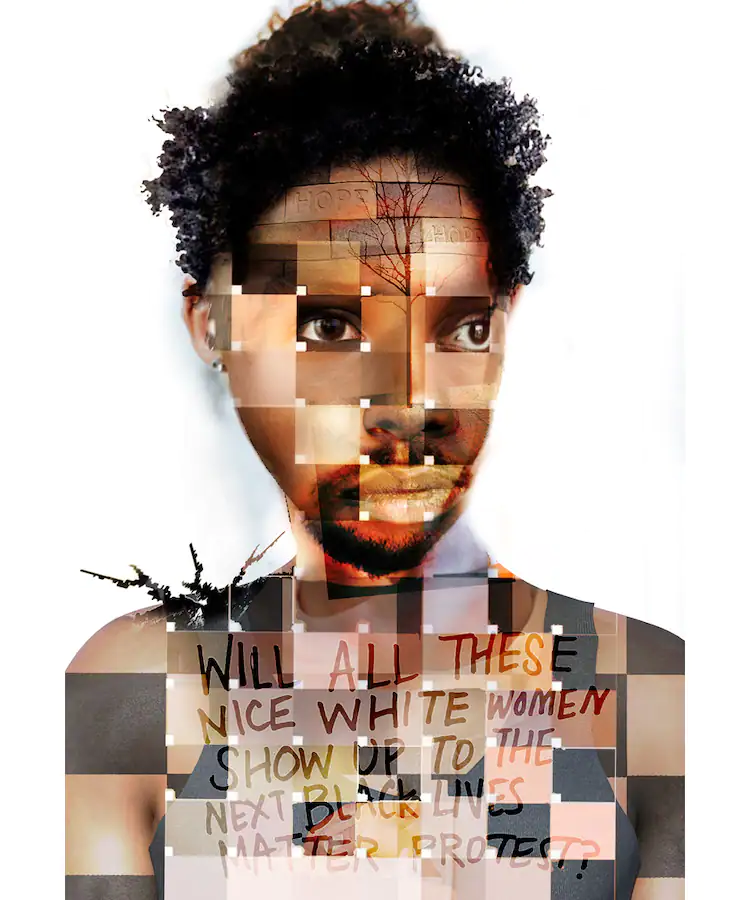The Burden by Z

(image by Jana Curcio)
Years ago, I had a conversation with two white women about the daily burden of being nonwhite in a world of whiteness. My ultimate point was we cannot understand because there is nothing like it in our white reality. We can empathize but the visceral aspect will always remain beyond our comprehension. It is a daily struggle that we as white people will never understand.
This conversation has stayed with me, and I continue to speak with these two well-meaning white women in my head.
I say: A nonwhite person can never be perceived as anything else. They cannot get away from it. It weighs down on one and affects them every time they leave their home. It colors their interactions and makes them question if race was involved in a negative interaction. Of course it was involved. A person cannot get beyond what they see!
Over the years I have watched how this white lack of understanding has played out in countless scenarios with people who are trying to help but actually finding excuses for the encounters. They look for those PLE (perfectly logical explanations) for the racist behavior. For me, actively listening and giving space to the person who is trying to work through the messy questions of a negative interaction is more supportive.
Being the white mother of nonwhite children, I have seen the pain of dealing with racism. I know that I can never understand the internal hurt that my children feel, but I can be there to listen and comfort.
For my own internalized racism, I have to work with it. I have to see how it comes out in me. Here are a few things I do.
- If I am in a situation where I need help and I can choose who will help me, I try to go against what is my internalized conditioning and challenge myself.
- If I see a group of young Latinos walking down my street, I try to imagine them as our future leaders.
- I try to speak Spanish to white people, so we know that there are other ways of communicating.
Challenging my own thinking in regard to how I see people and what I tell myself about them goes a long way as I try to undo the racism within myself.
PS: My use of the term non-white comes from Robert Jensen and his writings. https://robertwjensen.org
I hope his analysis will help clarify my usage of non-white.
“But politically, white is not just white, of course. White is power. And using the terms white/non-white reminds us of that. What do people of color have in common? That is, what makes the category “people of color” make sense? The only commonality is that the people in that category are on the subordinated side of white supremacy. Nothing intrinsically links people of indigenous, African, Latino, and Asian descent in the United States except their common experience of being targeted, abused, and victimized-albeit in different ways at different times-by a white-supremacist society. Take that experience away, and the category of “people of color” vanishes. The people, of course, don’t vanish, nor does their color change. But nothing links them except the experience of oppression. And the group perpetrating that oppression is white, another socially created category defined by power.
So, I want to put “white” at the center, but not in the sense of valorizing it or claiming it as a norm. Just the opposite. I want to frame the issue as white and non-white to highlight the depravity of white supremacy and identify it as the target. In this sense, I think white/non-white more clearly marks the political nature of the struggle whereas “people of color” for many tends to shift the focus from white supremacy to the varied cultures of those non-white people. Again, in many situations that shift is important, as white people learn more about other cultures and, we hope, understand both the unique contributions that various cultures make and the way in which all cultures share certain common qualities and values. Such understanding can contribute to the breakdown of white supremacy.”

Leave a Reply